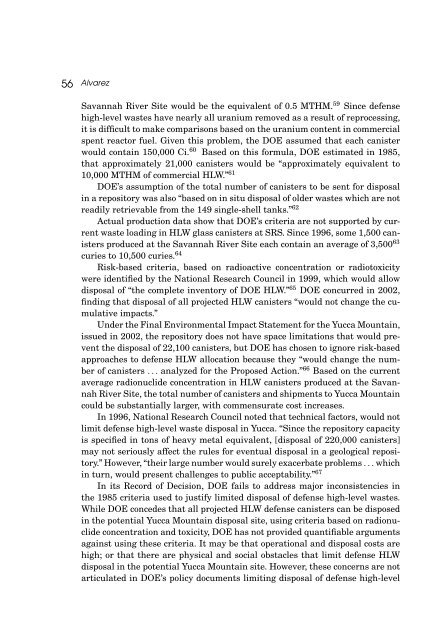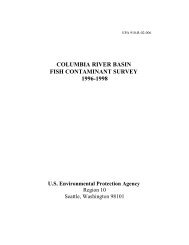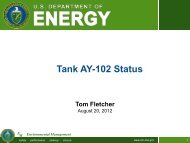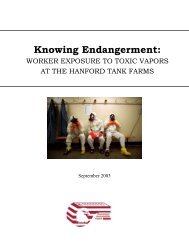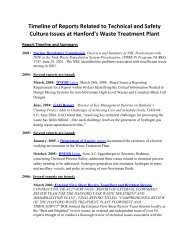Reducing the Risks of High-Level Radioactive Wastes at Hanford
Reducing the Risks of High-Level Radioactive Wastes at Hanford
Reducing the Risks of High-Level Radioactive Wastes at Hanford
Create successful ePaper yourself
Turn your PDF publications into a flip-book with our unique Google optimized e-Paper software.
56 Alvarez<br />
Savannah River Site would be <strong>the</strong> equivalent <strong>of</strong> 0.5 MTHM. 59 Since defense<br />
high-level wastes have nearly all uranium removed as a result <strong>of</strong> reprocessing,<br />
it is difficult to make comparisons based on <strong>the</strong> uranium content in commercial<br />
spent reactor fuel. Given this problem, <strong>the</strong> DOE assumed th<strong>at</strong> each canister<br />
would contain 150,000 Ci. 60 Based on this formula, DOE estim<strong>at</strong>ed in 1985,<br />
th<strong>at</strong> approxim<strong>at</strong>ely 21,000 canisters would be “approxim<strong>at</strong>ely equivalent to<br />
10,000 MTHM <strong>of</strong> commercial HLW.” 61<br />
DOE’s assumption <strong>of</strong> <strong>the</strong> total number <strong>of</strong> canisters to be sent for disposal<br />
in a repository was also “based on in situ disposal <strong>of</strong> older wastes which are not<br />
readily retrievable from <strong>the</strong> 149 single-shell tanks.” 62<br />
Actual production d<strong>at</strong>a show th<strong>at</strong> DOE’s criteria are not supported by current<br />
waste loading in HLW glass canisters <strong>at</strong> SRS. Since 1996, some 1,500 canisters<br />
produced <strong>at</strong> <strong>the</strong> Savannah River Site each contain an average <strong>of</strong> 3,500 63<br />
curies to 10,500 curies. 64<br />
Risk-based criteria, based on radioactive concentr<strong>at</strong>ion or radiotoxicity<br />
were identified by <strong>the</strong> N<strong>at</strong>ional Research Council in 1999, which would allow<br />
disposal <strong>of</strong> “<strong>the</strong> complete inventory <strong>of</strong> DOE HLW.” 65 DOE concurred in 2002,<br />
finding th<strong>at</strong> disposal <strong>of</strong> all projected HLW canisters “would not change <strong>the</strong> cumul<strong>at</strong>ive<br />
impacts.”<br />
Under <strong>the</strong> Final Environmental Impact St<strong>at</strong>ement for <strong>the</strong> Yucca Mountain,<br />
issued in 2002, <strong>the</strong> repository does not have space limit<strong>at</strong>ions th<strong>at</strong> would prevent<br />
<strong>the</strong> disposal <strong>of</strong> 22,100 canisters, but DOE has chosen to ignore risk-based<br />
approaches to defense HLW alloc<strong>at</strong>ion because <strong>the</strong>y “would change <strong>the</strong> number<br />
<strong>of</strong> canisters ... analyzed for <strong>the</strong> Proposed Action.” 66 Based on <strong>the</strong> current<br />
average radionuclide concentr<strong>at</strong>ion in HLW canisters produced <strong>at</strong> <strong>the</strong> Savannah<br />
River Site, <strong>the</strong> total number <strong>of</strong> canisters and shipments to Yucca Mountain<br />
could be substantially larger, with commensur<strong>at</strong>e cost increases.<br />
In 1996, N<strong>at</strong>ional Research Council noted th<strong>at</strong> technical factors, would not<br />
limit defense high-level waste disposal in Yucca. “Since <strong>the</strong> repository capacity<br />
is specified in tons <strong>of</strong> heavy metal equivalent, [disposal <strong>of</strong> 220,000 canisters]<br />
may not seriously affect <strong>the</strong> rules for eventual disposal in a geological repository.”<br />
However, “<strong>the</strong>ir large number would surely exacerb<strong>at</strong>e problems ...which<br />
in turn, would present challenges to public acceptability.” 67<br />
In its Record <strong>of</strong> Decision, DOE fails to address major inconsistencies in<br />
<strong>the</strong> 1985 criteria used to justify limited disposal <strong>of</strong> defense high-level wastes.<br />
While DOE concedes th<strong>at</strong> all projected HLW defense canisters can be disposed<br />
in <strong>the</strong> potential Yucca Mountain disposal site, using criteria based on radionuclide<br />
concentr<strong>at</strong>ion and toxicity, DOE has not provided quantifiable arguments<br />
against using <strong>the</strong>se criteria. It may be th<strong>at</strong> oper<strong>at</strong>ional and disposal costs are<br />
high; or th<strong>at</strong> <strong>the</strong>re are physical and social obstacles th<strong>at</strong> limit defense HLW<br />
disposal in <strong>the</strong> potential Yucca Mountain site. However, <strong>the</strong>se concerns are not<br />
articul<strong>at</strong>ed in DOE’s policy documents limiting disposal <strong>of</strong> defense high-level


